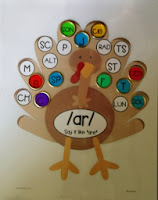Phew, between progress reports, parent-teacher conferences, and frantic attempts to cram as many groups as possible into our shortened minimum days, I completely managed to neglect this blog over the last few days. Now that Thanksgiving break is around the corner, things are finally calming down a bit. Time for an update!
I thought I would write about a specific approach that I used with one of my lower functioning ASD students to teach play-based turn-taking skills. With the rise in children diagnosed with Autism Spectrum Disorders we all have students working on social goals. This is an area that most of us do not feel super comfortable with since there seems to be a distinct lack of instruction on this topic in graduate school. In addition, often parents want to see playground/recess-based goals, which aren't always appropriate. I think parents don't understand that this type of outdoor play is extremely unstructured and overwhelming -- it is my belief that these kids need to master the skill in a highly structured environment first before we can take it outside. Also, I don't make it out on the playground as often as I want to, which makes it difficult to work on these goals with the necessary rigor.
Anyway, my student is a 3rd grade student attending our special day class. He has been diagnosed with ASD at an early age. Although he is verbal, his utterances are limited to delayed echolalia, refusal, and requesting desired items. His MLU is about 3-4. There is not much intrinsic motivation to engage in social activities or initiate conversations or other verbal exchanges. Of course, as with most parents of our ASD students, there was a push to include social goals in addition to language targets. During our sessions I noticed that although the student is able to adhere to rules of a simple game, he needed constant verbal prompting for each step in order to recognize when it was his turn, initiate, and then follow through with his turn. Because we often play games while working on our speech goals, I figured that this was something I could easily work on in the speech setting while practicing the rest of our targets. The goal I ended up drafting was as follows:
By (date), given an age-appropriate turn taking activity (i.e. a board game) with a peer or staff member, (student) will initiate his turn and follow through with it, with visual prompts only, 4/5 trials, in a structured setting, as measured by SLP observation and tally.
I selected three high interest target games and created three sets of visual prompts:
1. A choice board depicting the game selection and a sentence frame:
2. On the back of this card, I placed a visual reminder of "My turn":
3. I then continued to create visual rules for each of the three games:
It only took a few sessions for the student to learn to request a game appropriately and master the rules. If he did not initiate a turn, I briefly flashed or tapped the "My Turn" cue which sufficed to get him started. If he did not follow through with a turn, I tapped the specific rule. This approach really helped my little guy and by the end of the year he had gotten a lot better with turn-initiation (although we weren't able to completely fade out the "My Turn" visual). I think it is important though to see the growth and improvement with these students, even if it comes in small steps and minute increments...
~Viola
















